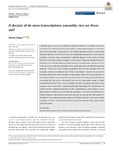A decade of de novo transcriptome assembly: Are we there yet?
Hölzer, Martin
A decade ago, de novo transcriptome assembly evolved as a versatile and powerful approach to make evolutionary assumptions, analyse gene expression, and annotate novel transcripts, in particular, for non‐model organisms lacking an appropriate reference genome. Various tools have been developed to generate a transcriptome assembly, and even more computational methods depend on the results of these tools for further downstream analyses. In this issue of Molecular Ecology Resources, Freedman et al. (Mol Ecol Resourc 2020) present a comprehensive analysis of errors in de novo transcriptome assemblies across public data sets and different assembly methods. They focus on two implicit assumptions that are often violated: First, the assembly presents an unbiased view of the transcriptome. Second, the expression estimates derived from the assembly are reasonable, albeit noisy, approximations of the relative frequency of expressed transcripts. They show that appropriate filtering can reduce this bias but can also lead to the loss of a reasonable number of highly expressed transcripts. Thus, to partly alleviate the noise in expression estimates, they propose a new normalization method called length‐rescaled CPM. Remarkably, the authors found considerable distortions at the nucleotide level, which leads to an underestimation of diversity in transcriptome assemblies. The study by Freedman et al. (Mol Ecol Resourc 2020) clearly shows that we have not yet reached “high‐quality” in the field of transcriptome assembly. Above all, it helps researchers be aware of these problems and filter and interpret their transcriptome assembly data appropriately and with caution.
Dateien zu dieser Publikation

